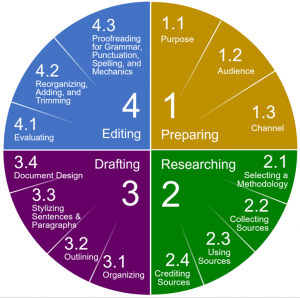Chapter 2: The Writing Process I: MAPS
If you’re ever lost, look at your MAPS.
When communication is approached as a form of FACED problem-solving, a lot of thinking goes on before you begin drafting your message. You Find the problem, Ask what’s at stake, Consider options and resources, and Evaluate solutions. This puts you in a strong position to Draft and deliver meaningful communication.
These next few chapters help you transition from the “problem-solving” or “pre-writing” steps to drafting. Remember, your message must be shaped by an awareness of audience, purpose, and style of communication. You can remember this with the acronym MAPS. By figuring out these pieces, your communication will more easily take shape.
- Message: What is the main idea that I need to communicate? Are there any other pieces I need to explain?
- Audience: Who is receiving my message? What do they expect? What are they willing to hear? What are they able to understand? Can I shape the message to align with their wants, needs, or perspective?
- Purpose: Why am I communicating in this situation? Do I need information? Am I trying to change someone’s attitude or behaviour? Am I trying to tell someone about my best qualities so that I can get a job, or am I trying to sell something to someone? Is my tone appropriate for that purpose?
- Style: What communication channel offers the best fit between my message and my purpose? (ex. email, text, phone call, video conference, face-to-face meeting, letter, memo, academic essay, formal report, grant proposal, and so on). If I’m writing, are my spelling, grammar, and paragraphing correct? If I’m speaking, are my vocabulary and pronunciation correct?
Organized this way, the MAPS elements look tidy and distinct. Keep in mind, however, that when you’re actually drafting in a real writing process, things can get a little messy. Authentic communication is all about making choices. This is the creative challenge of drafting. Once you make a decision about message, audience, purpose, or style, there is a ripple effect. You have to adapt the other elements to make sure that they are consistent and balanced with each other. This is both the most fun part and most frustrating part of writing!
Consider this example:
Ask yourself, what do you think about Artificial Intelligence tools like ChatGPT?
You probably have some ready-to-go ideas already. Your instincts might tell you that ChatGPT is a pretty useful, pretty harmless way to speed up the writing process. If you’re in a low-stakes, casual conversation with other students, your opinion–this message–might come out pretty naturally with very little effort. After all, in a low-stakes, casual conversation, your purpose might simply be to pass the time or make new friends.
However, if your audience is your professor, the risks and benefits are different. You might feel that your credibility or reputation as a student is at stake. In that situation, you’ll probably choose your words with more carefully. This is another way of saying that your audience awareness causes you to pay more careful attention to style. When you pay careful attention to audience and style in this situation, you might find yourself modifying your ideas about ChatGPT. Your message might change slightly.
Your message might even change significantly if you were caught using ChatGPT when it wasn’t an authorized resource! In those situations, students are required to fill out an official Academic Offences form. Communicating on a formal document has a way of drastically altering your usual communication style. This is because of the stakes: your purpose is to avoid failing the course and your audience is not only your professor, but also the Associate Dean and the Student Rights and Responsibility Office. In that situation, your message, audience, style, and purpose will change drastically compared to that original casual conversation!
To offer another example: if your best friend asked you to describe the best night of your life, what memory would you share? How would that story change if it was your mother who asked? How would your answer change if you were in a job interview and the employer asked? The point is that we naturally adjust our message to audience, purpose, and style all the time. The challenge here is take control of that process so that you are making intentional, authentic choices that empower you in any communication situation.
A more traditional model of pre-writing is represented by this visual graphic:
Figure 2: The four-stage writing process. The preparation stage is shown in Section 1 (the yellow section).


